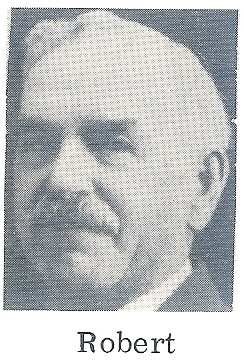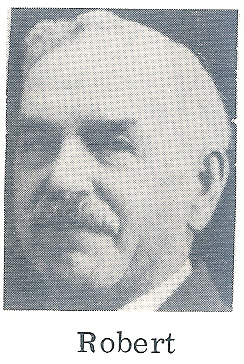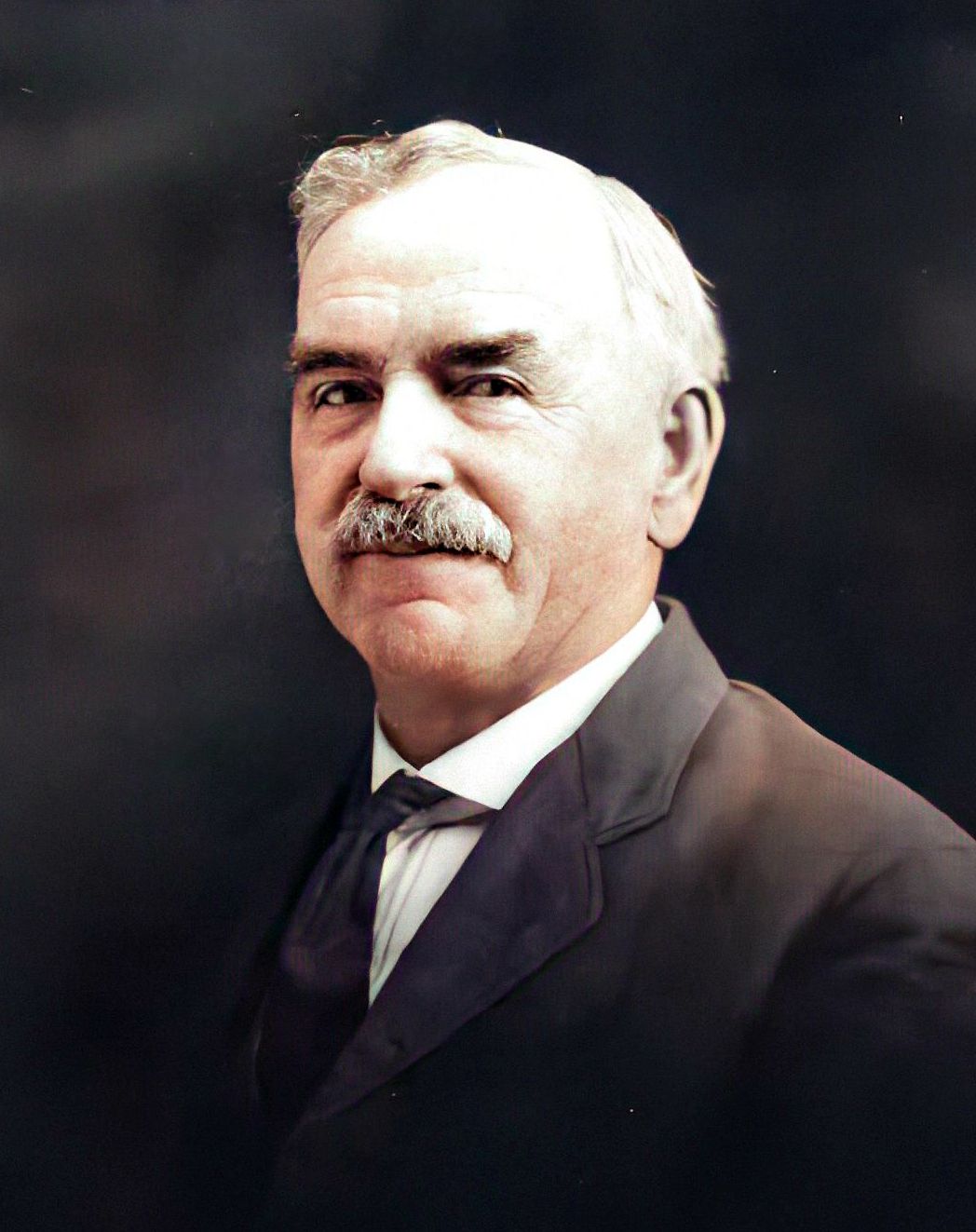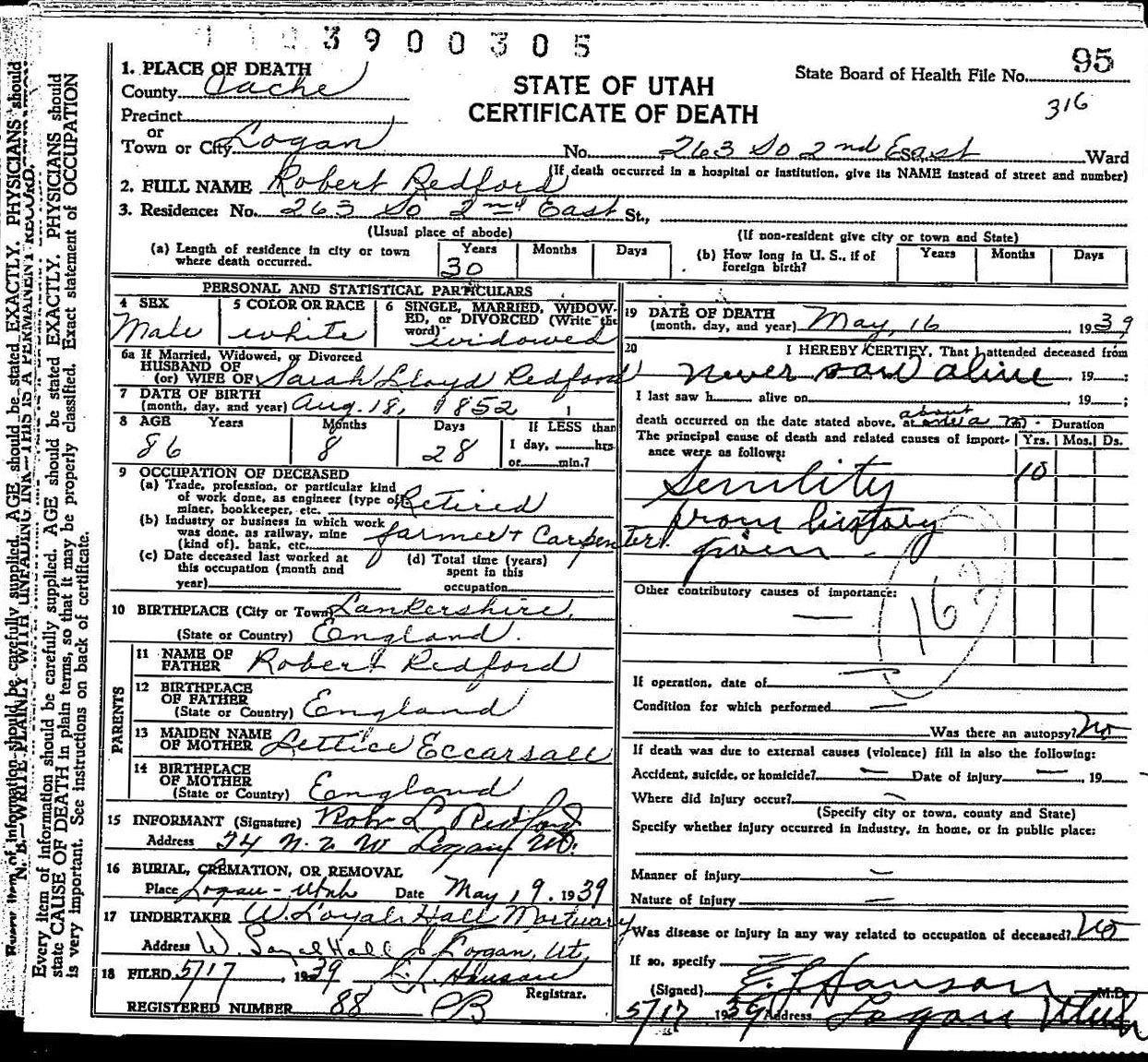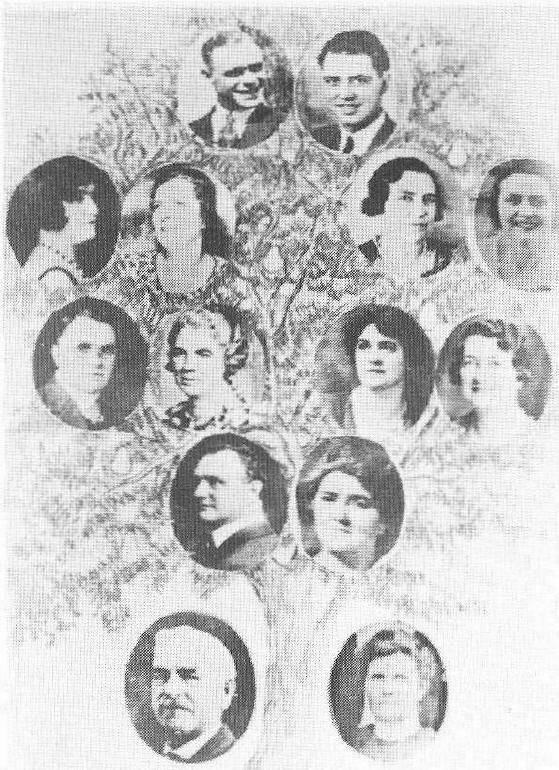(The following is told by Robert also recollections of his children.)
I lived in Halfacre until four years of age then moved to Besses 0th' Barn where mother worked as a winder or spinner in a cloth factory. The Saints met in the upper store room of a building. I accompanied mother to all the meetings and well remember a sign which hung in the room, "Truth Is Mighty And Will Prevail". The man who lived on the main floor was very antagonistic toward the Mormons and while the meetings were in session would pound on the ceiling to disturb or break them up.
When eight years old I went to work in James Farrer Factory at Chapel Field. My job was to carry the empty bobbins (spools) from the weavers to the winding or spinning room. My wages were twelve cents (American money) per week. I had to be to work by six A. M.; work until noon; had an hour for dinner; walk one-half mile home, then walk another one and. one-half miles to school. It was one-half day at work and one- half day at school. This I did until nearly thirteen years old, which ended my education and I was allowed to work all day at the Crow Oaks Bleach Works. I later went to work in Stand Lane Coal Pit which was 1125 feet deep and one-half mile under ground. My job was wagoneer. I took the wagons filled with coal from the miner to where they could be hauled to the bottom of the pit.
On 30 June 1868, mother, my brother Abraham, and myself, set sail for America on the Steamship "Minnesota" with John Price as Captain. The voyage took eleven days and twelve hours. We worked for part of our passage. We landed in New York 12 July 1868. I was fifteen years old. We went on a tug boat to the Railroad Station and from there I rode on top of a Union Pacific Railroad box car to Laramie, Wyo., arriving 25 July 1867. Here we met a company of wagons from Utah who had come to aid emigrants to Salt Lake City. To protect us from Indians on the way, whenever we stopped to make camp at noon or night, we arranged our wagons in a circle with the front wheels of one wagon against the rear wheels of the other one with the tongues outside, making a solid corral. A rope drawn across the road would keep the stock inside. The steers were used for meat and killed as needed. We gathered buffalo chips for fuel.
We arrived in Salt Lake City 20 Aug 1868. One of mother's friends, James Crossicy, from the same branch in England, took us to where we could have a good dinner. The next morning we started for Cache Valley with Richard Williams as teamster of our wagon. He was employed by Frank (Dick) Gunnell. About one-half mile on the Box Elder side of Sardine Canyon my brother met us. We went to his home in Wellsville which was built of rocks cemented together with black mud. It had a dirt roof and a dirt floor.
In the spring of 1870 I hired out to herd sheep in Sevier County in Southern Utah where I worked all winter. The next winter I worked in a cabinet shop making chairs, bedsteads, lounges and cupboards for fifty cents a day and boarded myself. This was the winter my brother John, froze his feet, having gone across the valley to collect a debt. It was a very cold and frosty day and when he walked in that night his feet sounded like rocks hitting the floor. They were frozen so badly we had to cut his shoes off. His hands and nose were also frozen. He could barely speak but we understood, "Boys I'm frozen". Then he fell unconscious to the floor. When we had him thawed out he told us he had fallen from his horse two miles from home and that our father, who had been dead for three years, had lifted him onto his feet and started him on his way again. He went a short distance but fell down again. The second time his father picked him up and started him on his way. This time he reached home. He had to have all the toes on his left foot and all but the great toe on his right one removed. He suffered much all his life because of this. A few weeks before he died I asked him to relate the experience to his family, which he did, bearing witness that it was true.
I worked in a Wyoming sawmill in 1872 then hauled charcoal for forty dollars a month. I was one of six boys called to help build the St. George Temple. When I returned home I worked on the Railroad from Logan to Franklin. I did some freighting from Franklin, Idaho, to Deer Lodge, Montana. I would haul my load to Montana, then bring a load of merchandise on the return trip.
I joined the Wellsville band and played the trumpet. When President Brigham Young visited in Cache Valley, our band met him at the top of Sardine Canyon to escort him and his company to Logan. We did the same when Presidents John Taylor, Willford Woodruff and Lorenzo Snow came. I also belonged to the Wellsville Choir. We went to Logan to sing in the old Bowery.
In 1877 I traded a fine team of horses for a City lot in Wellsville where I planted an orchard and a year later built a home then took my mother to live with me. After marriage Sarah and I returned to Wellsville to live. Later I bought forty acres of land South of Wellsville, planted an orchard with all kinds of fruit and dug a well seventy feet deep. I was building houses, barns and granaries. I was able to build a seven room house on the farm and in 1886 sold the home in town and moved the family to the new one. I built a room for my mother where she lived until her death 1 Mar 1900. I worked on the farm raising sugar cane and was also employed as water master for the Water Company. In l889 we had a drought, also grasshoppers and Mormon crickets took our crops. We had to glean the wheat fields to get enough wheat for flour, so that winter I went to Rock Springs, Wyo., to work in the coal mines until 8 Feb 1889 then decided to leave my job and go home. I boarded the train and rode to Mendon then walked eight miles to Wellsville and the extra two miles to the farm. There was enough snow that I could walk over the tops of the fences. (The remainder of history added by children.)
In 1906 the farm was sold and the family moved to River Heights to live for a short time, later moving to a new home in Logan which Robert had built. After the death of his wife, Sarah, Robert worked around Logan going occasionally to Idaho in the summer to help with building there. He met and married Sarah Susannah Blackburn Briggs, (a widow) 7 Feb 1923. They did much temple work. She passed away at Archer, Idaho, 20 Oct 1930. Robert spent his remaining years visiting his children and their families.
Robert helped to organize Mt. Sterling lard and in building the Meeting House. He held many offices in the church and in the community. He was an accomplished and gifted musician. He baptized numerous people in the creek which ran through his farm. He also helped haul, rock and lumber to build the Logan Temple and was instrumental in getting Rural Free Nail Delivery for Mt. Sterling.
Robert and Sarah Susannah had the following children:
Robert Lloyd Redford,
Sarah Susannah Lloyd Redford,
Thomas Lloyd Redford,
Millie Lloyd Redford,
Nora Lettice Lloyd Redford,
Mary Lloyd Redford,
Ivy Louise Lloyd Redford,
Elva Lloyd Redford,
Ruby Lloyd Redford,
Martha Ida Lloyd Redford,
Rulon Lloyd Redford,
John Vernon Lloyd Redford.
(The following is told by Robert also recollections of his children.)
I lived in Halfacre until four years of age then moved to Besses 0th' Barn where mother worked as a winder or spinner in a cloth factory. The Saints met in the upper store room of a building. I accompanied mother to all the meetings and well remember a sign which hung in the room, "Truth Is Mighty And Will Prevail". The man who lived on the main floor was very antagonistic toward the Mormons and while the meetings were in session would pound on the ceiling to disturb or break them up.
When eight years old I went to work in James Farrer Factory at Chapel Field. My job was to carry the empty bobbins (spools) from the weavers to the winding or spinning room. My wages were twelve cents (American money) per week. I had to be to work by six A. M.; work until noon; had an hour for dinner; walk one-half mile home, then walk another one and. one-half miles to school. It was one-half day at work and one- half day at school. This I did until nearly thirteen years old, which ended my education and I was allowed to work all day at the Crow Oaks Bleach Works. I later went to work in Stand Lane Coal Pit which was 1125 feet deep and one-half mile under ground. My job was wagoneer. I took the wagons filled with coal from the miner to where they could be hauled to the bottom of the pit.
On 30 June 1868, mother, my brother Abraham, and myself, set sail for America on the Steamship "Minnesota" with John Price as Captain. The voyage took eleven days and twelve hours. We worked for part of our passage. We landed in New York 12 July 1868. I was fifteen years old. We went on a tug boat to the Railroad Station and from there I rode on top of a Union Pacific Railroad box car to Laramie, Wyo., arriving 25 July 1867. Here we met a company of wagons from Utah who had come to aid emigrants to Salt Lake City. To protect us from Indians on the way, whenever we stopped to make camp at noon or night, we arranged our wagons in a circle with the front wheels of one wagon against the rear wheels of the other one with the tongues outside, making a solid corral. A rope drawn across the road would keep the stock inside. The steers were used for meat and killed as needed. We gathered buffalo chips for fuel.
We arrived in Salt Lake City 20 Aug 1868. One of mother's friends, James Crossicy, from the same branch in England, took us to where we could have a good dinner. The next morning we started for Cache Valley with Richard Williams as teamster of our wagon. He was employed by Frank (Dick) Gunnell. About one-half mile on the Box Elder side of Sardine Canyon my brother met us. We went to his home in Wellsville which was built of rocks cemented together with black mud. It had a dirt roof and a dirt floor.
In the spring of 1870 I hired out to herd sheep in Sevier County in Southern Utah where I worked all winter. The next winter I worked in a cabinet shop making chairs, bedsteads, lounges and cupboards for fifty cents a day and boarded myself. This was the winter my brother John, froze his feet, having gone across the valley to collect a debt. It was a very cold and frosty day and when he walked in that night his feet sounded like rocks hitting the floor. They were frozen so badly we had to cut his shoes off. His hands and nose were also frozen. He could barely speak but we understood, "Boys I'm frozen". Then he fell unconscious to the floor. When we had him thawed out he told us he had fallen from his horse two miles from home and that our father, who had been dead for three years, had lifted him onto his feet and started him on his way again. He went a short distance but fell down again. The second time his father picked him up and started him on his way. This time he reached home. He had to have all the toes on his left foot and all but the great toe on his right one removed. He suffered much all his life because of this. A few weeks before he died I asked him to relate the experience to his family, which he did, bearing witness that it was true.
I worked in a Wyoming sawmill in 1872 then hauled charcoal for forty dollars a month. I was one of six boys called to help build the St. George Temple. When I returned home I worked on the Railroad from Logan to Franklin. I did some freighting from Franklin, Idaho, to Deer Lodge, Montana. I would haul my load to Montana, then bring a load of merchandise on the return trip.
I joined the Wellsville band and played the trumpet. When President Brigham Young visited in Cache Valley, our band met him at the top of Sardine Canyon to escort him and his company to Logan. We did the same when Presidents John Taylor, Willford Woodruff and Lorenzo Snow came. I also belonged to the Wellsville Choir. We went to Logan to sing in the old Bowery.
In 1877 I traded a fine team of horses for a City lot in Wellsville where I planted an orchard and a year later built a home then took my mother to live with me. After marriage Sarah and I returned to Wellsville to live. Later I bought forty acres of land South of Wellsville, planted an orchard with all kinds of fruit and dug a well seventy feet deep. I was building houses, barns and granaries. I was able to build a seven room house on the farm and in 1886 sold the home in town and moved the family to the new one. I built a room for my mother where she lived until her death 1 Mar 1900. I worked on the farm raising sugar cane and was also employed as water master for the Water Company. In l889 we had a drought, also grasshoppers and Mormon crickets took our crops. We had to glean the wheat fields to get enough wheat for flour, so that winter I went to Rock Springs, Wyo., to work in the coal mines until 8 Feb 1889 then decided to leave my job and go home. I boarded the train and rode to Mendon then walked eight miles to Wellsville and the extra two miles to the farm. There was enough snow that I could walk over the tops of the fences. (The remainder of history added by children.)
In 1906 the farm was sold and the family moved to River Heights to live for a short time, later moving to a new home in Logan which Robert had built. After the death of his wife, Sarah, Robert worked around Logan going occasionally to Idaho in the summer to help with building there. He met and married Sarah Susannah Blackburn Briggs, (a widow) 7 Feb 1923. They did much temple work. She passed away at Archer, Idaho, 20 Oct 1930. Robert spent his remaining years visiting his children and their families.
Robert helped to organize Mt. Sterling lard and in building the Meeting House. He held many offices in the church and in the community. He was an accomplished and gifted musician. He baptized numerous people in the creek which ran through his farm. He also helped haul, rock and lumber to build the Logan Temple and was instrumental in getting Rural Free Nail Delivery for Mt. Sterling.
Robert and Sarah Susannah had the following children:
Robert Lloyd Redford,
Sarah Susannah Lloyd Redford,
Thomas Lloyd Redford,
Millie Lloyd Redford,
Nora Lettice Lloyd Redford,
Mary Lloyd Redford,
Ivy Louise Lloyd Redford,
Elva Lloyd Redford,
Ruby Lloyd Redford,
Martha Ida Lloyd Redford,
Rulon Lloyd Redford,
John Vernon Lloyd Redford.
Family Members
-
![]()
Robert Lloyd Redford
1880–1953
-
![]()
Sarah Susannah Lloyd Redford Brown
1881–1949
-
![]()
Thomas Lloyd Redford
1883–1968
-
![]()
Millie Lloyd Redford Griffin
1885–1967
-
![]()
Nora Lettice Redford Clarke
1886–1980
-
![]()
Mary Lloyd Redford Stoddard
1889–1989
-
![]()
Ivy Louise Lloyd Redford Sorensen Palmer
1891 – unknown
-
![]()
Elva Lloyd Redford Boudrero
1893–1989
-
![]()
Ruby Lloyd Redford Glad
1896–1953
-
![]()
Martha Ida Lloyd Redford
1898–1920
-
![]()
Rulon Lloyd Redford
1900–1985
-
![]()
John Vernon Lloyd Redford
1906–1976
Sponsored by Ancestry
Advertisement
Explore more
Sponsored by Ancestry
Advertisement
